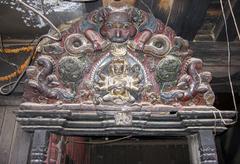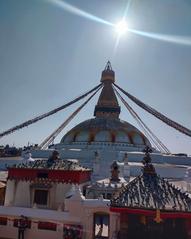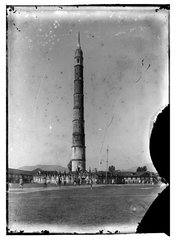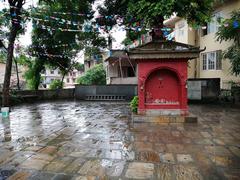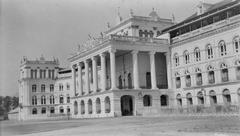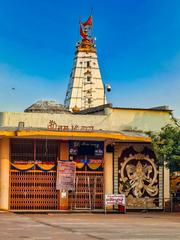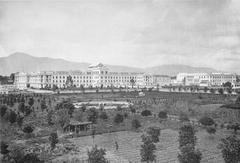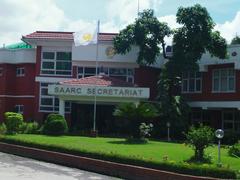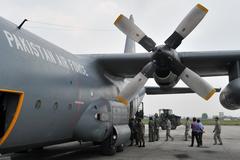Kasthamandap Visiting Hours, Tickets, and Kathmandu Historical Sites Guide
Date: 04/07/2025
Introduction to Kasthamandap and Its Historical Importance
Kasthamandap, an iconic wooden pavilion at the heart of Kathmandu Durbar Square, is much more than an architectural landmark—it’s the origin of Kathmandu’s name and a living symbol of Nepal’s rich cultural and spiritual legacy. With roots believed to extend back to the 7th-century Licchavi era, Kasthamandap has served as a rest house, community center, and religious shrine over centuries (Top Nepal; Kathmandu Post; Wikipedia). Its legendary construction from a single sal tree, dedication to sage Gorakhnath, and role in Kathmandu’s major festivals illustrate its enduring spiritual and communal significance.
Heavily damaged in the 2015 Gorkha earthquake, Kasthamandap’s painstaking reconstruction now stands as a beacon of resilience, blending traditional Newari craftsmanship with seismic-strengthened methods. As a centerpiece of the UNESCO World Heritage-listed Kathmandu Durbar Square, Kasthamandap remains a focal point for both local life and the global community of heritage travelers (MyRepublica; Altitude Himalaya).
This comprehensive guide provides everything you need to know—from Kasthamandap’s compelling history and architecture to visiting hours, tickets, accessibility, travel tips, and nearby attractions.
Table of Contents
- Introduction
- Origins and Early History
- Architectural Features and Construction
- Myths, Legends, and Religious Associations
- Role in Kathmandu’s Urban and Cultural Development
- Earthquake Damage and Reconstruction
- Visiting Kasthamandap: Practical Information
- Visual and Interactive Elements
- Frequently Asked Questions (FAQ)
- Conclusion
Origins and Early History
The name “Kasthamandap” is derived from Sanskrit and Nepal Bhasa—‘Kastha’ meaning wood and ‘Mandap’ meaning pavilion—cementing its foundational place in Kathmandu’s identity (Top Nepal). Although once attributed to the 16th or 17th century Malla kings (Geographies.gr), recent archaeological research confirms its construction dates back to the 7th-century Licchavi era (Kathmandu Post). Manuscripts from the 13th and 14th centuries further document Kasthamandap’s early communal and religious importance (Wikipedia).
Architectural Features and Construction
Kasthamandap’s three-tiered pagoda design is a showcase of Newar artistry. Sixteen massive wooden pillars, including four central columns, support the pavilion—its woodwork traditionally believed to be sourced from a single sal (Shorea robusta) tree (Himalayan Dreams). The structure’s vast, open interiors historically hosted traders and pilgrims, while intricate carvings and multi-tiered eaves embody the region’s spiritual and artistic traditions (Academia.edu).
Myths, Legends, and Religious Associations
Local legend claims Kasthamandap was built from a single miraculous tree, echoing the mythic Kalpavriksha or wish-fulfilling tree (Geographies.gr). Another tale recounts how sage Gorakhnath’s powers caused a giant tree to grow, which supplied all the wood needed (Himalayan Dreams). Over time, the pavilion became a shrine to Gorakhnath, with walls inscribed with sacred texts (Top Nepal; Nepal Traveller).
Role in Urban and Cultural Life
Kasthamandap has been pivotal in shaping Kathmandu’s urban landscape. Located at the heart of Hanuman Dhoka Durbar Square, it has served as a rest stop for traders, a site for public gatherings, and a stage for major festivals including Indra Jatra and Machhindranath Jatra (Top Nepal; UNESCO). Its endurance through centuries of political and natural upheavals makes it a living symbol of Kathmandu’s resilience (Academia.edu).
Earthquake Damage and Reconstruction
Kasthamandap suffered serious damage in the 1934 earthquake and total collapse in the 2015 Gorkha earthquake (Wikipedia). Its loss was deeply felt, as the pavilion represented both the city’s name and its communal heart (QualityDays).
The Nepalese government, with UNESCO and community partners, prioritized its restoration. The Kasthamandap Reconstruction Committee, led by Rajesh Shakya, managed the Rs 190 million project, sourcing over 17,000 cubic feet of timber from the Rautahat district (MyRepublica). By early 2025, the project was nearing completion, using traditional Newari techniques and modern seismic enhancements to ensure both authenticity and safety (Heritage as Placemaking).
Community participation has been central throughout, with local artisans and residents contributing to physical reconstruction and decision-making. This collaborative approach has preserved both the tangible and intangible heritage that Kasthamandap represents (QualityDays).
Visiting Kasthamandap: Practical Information
Location and How to Get There
Kasthamandap is centrally located within Kathmandu Durbar Square, Durbar Square, Kathmandu 44600, Nepal (Trip.com). It’s a 15–20 minute walk from Thamel via Thahiti Chowk, Ason Chowk, and Indra Chowk (The Longest Way Home). Taxis, rickshaws, and ride-sharing apps like Pathao and InDrive are also convenient options (Grrrl Traveler).
Visiting Hours
- Kasthamandap: Open daily, typically from 9:00 AM to 6:00 PM for visitors.
- Kathmandu Durbar Square: Open 24/7, but main attractions are best accessed during daylight (Altitude Himalaya; Trip.com).
Tickets and Entry Fees
- Nepalese citizens: Free
- SAARC nationals: NPR 150
- Other foreign nationals: NPR 1,000
- Children under 10: Free
The ticket covers all main sites within Kathmandu Durbar Square, including Kasthamandap. Tickets are valid for one day but can be extended for the duration of your visa at the ticket booth (Altitude Himalaya).
Accessibility
Kasthamandap’s ground floor is accessible, but uneven paving and lack of ramps or elevators make upper floors and some areas challenging for visitors with mobility impairments. Accessibility improvements are ongoing, with ramps at main entrances and assistance available upon request (MyRepublica).
Guided Tours and Heritage Walks
Local guides and operators offer in-depth tours of Kathmandu Durbar Square, including Kasthamandap, highlighting the site’s history, architecture, and restoration. Audio guides and self-guided materials are also available (The Longest Way Home).
Photography, Etiquette, and Safety
- Photography: Permitted, but always ask before photographing people, especially priests or worshippers.
- Etiquette: Dress modestly, covering shoulders and knees. Remove shoes before entering sacred spaces.
- Safety: The site is generally safe, but stay alert for pickpockets during crowded events. Bottled or filtered water is recommended (Grrrl Traveler).
Facilities and Amenities
Surrounding Kasthamandap are vibrant markets—flower vendors, fish and vegetable stalls, and a priests’ house accessible via a signature red door (The Longest Way Home). Public restrooms are available within the square but may be basic. Thamel, nearby, offers cafes, restaurants, and a range of hotels (Grrrl Traveler).
Best Times to Visit
October to April offers the most pleasant weather for sightseeing, with clear skies and moderate temperatures (Travellers Worldwide). Early mornings and evenings provide the best light for photography and a quieter atmosphere (Altitude Himalaya). Monsoon months (June–August) bring afternoon rains and humidity (Travelling Mandala).
Festivals and Special Events
Kasthamandap is a focal point during major festivals, particularly Indra Jatra in September, when processions, masked dances, and rituals animate Durbar Square (HopNepal). These events offer unique cultural experiences, though they can be crowded.
Nearby Attractions
Within walking distance are:
- Kumari Ghar: Residence of the Living Goddess
- Taleju Temple: Tallest temple in the square, open to the public only during Dashain festival
- Jagannath Temple: Renowned for its wood carvings (HopNepal)
- Hanuman Dhoka Palace Museum
- Swayambhunath Stupa (Monkey Temple): A short taxi ride away
- Thamel: Kathmandu’s tourist hub for shopping and dining
Responsible Tourism
Kasthamandap’s reconstruction exemplifies the power of community-led heritage preservation (Rebuild Kasthamandap). Visitors are encouraged to respect the monument’s sacredness and contribute to ongoing preservation through responsible tourism and, if desired, donations.
Frequently Asked Questions (FAQ)
What are Kasthamandap’s visiting hours?
9:00 AM to 6:00 PM, with Kathmandu Durbar Square open 24/7.
How much does entry cost?
NPR 1,000 for most foreign nationals, NPR 150 for SAARC nationals. Free for Nepalese citizens and children under 10.
Is Kasthamandap accessible for people with disabilities?
The ground floor is accessible, but uneven paving and stairs limit access to upper floors.
Are guided tours available?
Yes, through local operators and online booking.
Can I take photographs?
Photography is generally permitted; ask before photographing individuals.
Visual and Interactive Resources
For an enhanced experience, explore virtual tours, maps, and high-resolution images of Kasthamandap and Kathmandu Durbar Square via tourism and heritage websites. Use descriptive alt text (e.g., “Kasthamandap wooden pavilion in Kathmandu Durbar Square”) for images.
Conclusion
Kasthamandap stands as a testament to Kathmandu’s layered history, spiritual diversity, and architectural mastery. Its survival and rebirth after the 2015 earthquake underscores the resilience of Nepal’s people and the enduring value of cultural preservation. Whether you’re a curious traveler, heritage enthusiast, or spiritual explorer, Kasthamandap offers a profound window into Nepal’s past and present.
Plan your visit, respect local traditions, and immerse yourself in the unique energy of this Kathmandu landmark. For personalized itineraries and the latest updates, download the Audiala app and follow heritage news on social media.
Summary and Encouragement to Explore Further
Kasthamandap is more than a monument—it’s the living heart of Kathmandu’s historic and cultural identity. From its legendary single-tree construction to its central role in urban life and festivals, it embodies the artistry, spirituality, and communal spirit of Nepal. The collaborative reconstruction after the 2015 earthquake is a source of national pride and global inspiration (MyRepublica; Top Nepal).
Engage deeply with Kathmandu’s heritage by exploring Kasthamandap and its surroundings, supporting preservation initiatives, and staying informed with tools like the Audiala app. In doing so, you become part of Kathmandu’s ongoing story—one of resilience, tradition, and vibrant living culture (Altitude Himalaya; Rebuild Kasthamandap).
References
- Kasthamandap: A Historic Wooden Pavilion and Must-Visit Kathmandu Historical Site | Visiting Hours, Tickets & More, 2023, Top Nepal
- Restoring Maru Satta Kasthamandap, 2018, Kathmandu Post
- Kasthamandap, 2023, Wikipedia
- Kasthamandap Reconstruction is 85 Percent Complete, 2025, MyRepublica
- Kathmandu Durbar Square, 2023, Altitude Himalaya
- Kasthamandap Temple: Visiting Hours, Tickets, and History of Kathmandu’s Iconic Wooden Pavilion, 2023, GPSmyCity
- Kasthamandap or the Wooden Pavilion, 2023, Another Global Eater
- Kasthamandap’s Journey through History, Himalayan Dreams
- Kasthamandap Microcosm of Kathmandu’s Living Culture and Storied History, 2023, Academia.edu
- Kasthamandap Visiting Hours, Tickets, and Travel Guide to Kathmandu’s Historic Landmark, 2024, Trip.com
- More Things to Know Before You Go to Nepal, 2023, Grrrl Traveler
- HopNepal Blog: Best Natural and Must See Places to Visit and Hangout in Kathmandu, 2023
- Rebuild Kasthamandap, 2024
